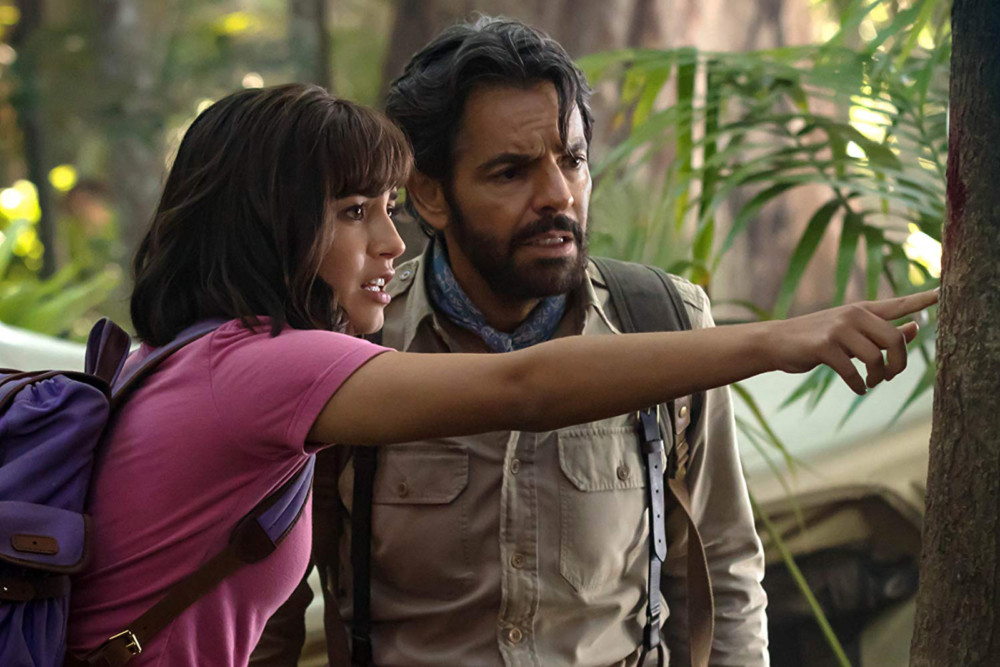By Rafer Guzmán
Newsday
WWR Article Summary (tl;dr) “Dora and the Lost City of Gold” marks the rare Hollywood release with an almost entirely Hispanic cast.
Newsday
When 8-year-old Evelyn Morales immigrated to Hampton Bays, N.Y., from Argentina with her family, she couldn’t speak a word of English. School, she says, typically included tears of frustration and various excuses to hide out in the nurse’s office.
That is, until she discovered the Nickelodeon cartoon series “Dora the Explorer,” about a young Latina who embarks on whimsical adventures while teaching her viewing audience how to speak Spanish and English.
“I give Dora a lot of respect and credit for me learning English,” says Morales, 25, who graduated from LIU Riverhead with a degree in communications and now works as a nanny and part-time entrepreneur. “I just repeated things, even though I didn’t understand. I would say a word, and people would start to understand me. And then I’d realize I was doing it right.”
The animated, bilingual explorer is making her big-screen debut with “Dora and the Lost City of Gold.” It’s a live-action adaptation that seems sure to appeal to Dora’s young fans, though the character is no longer a little girl but a high schooler played by Isabela Moner (Broadway’s “Evita”).
buy azithromycin online https://blackmenheal.org/wp-content/languages/new/us/azithromycin.html no prescription
Perhaps most importantly, “Dora and the Lost City of Gold” marks the rare Hollywood release with an almost entirely Hispanic cast. Moner’s co-stars include Michael Penna and Eva Longoria as Dora’s parents; Eugenio Derbez as a hapless adventurer; and Benicio Del Toro as the voice of Swiper, the thieving fox.
“I’ve never seen such a big cast full of Latinos, and they’re headlining it, really carrying the show,” says Moner, 18. “And the movie does include a lot of Spanish. There’s a bit of breaking the fourth wall. I think it’s going to be a fun one.”
The “Dora” series wasn’t initially aiming for the Latino market. In the late 1990s, the show’s creators, Val Walsh and Chris Gifford, were looking to replicate the success of Nickelodeon’s “Blue’s Clues,” the popular educational series about a giant dog.
The team reportedly kicked around several character ideas, a rabbit, an alien, a girl named Tess, before a Nickelodeon executive suggested making the heroine a Latina. Cultural advisers were brought in. And in June 1999, Nickelodeon aired the pilot for “Dora the Explorer.”
With her talking backpack and map, plus a loyal monkey named Boots, Dora became a runaway success.
“Dora the Explorer” spawned the usual merchandise, dolls, board games, clothing, handbags, along with Lego kits, video games and a book series. There have been several touring stage productions. The show has been translated into scores of other languages, including French, Swedish, Russian and Chinese. A spinoff, “Go, Diego, Go!,” based on Dora’s cousin, launched in 2005.
“Dora is iconic,” says Moner, an Ohio native of Peruvian descent who credits the show with teaching her Spanish. “When I cut my own bangs, when I was about 5, everyone started calling me Dora.”
In the summer of 2018, the studio behind “Dora and the Lost City of Gold,” Paramount Pictures, ran into trouble with the National Hispanic Media Coalition, a Pasadena-based advocacy group.
According to the Coalition, Paramount had one of Hollywood’s worst track records for putting Latinos on screen. Attempts to persuade the studio to sign a memorandum of understanding to hire more Latinos failed, according to Alex Nogales, the Coalition’s President and CEO. Protest rallies and calls for a boycott of Paramount films followed.
“We were aware that ‘Dora the Explorer’ was going to be coming out,” says Nogales. “And as soon as we put the pressure on them, they hired three of the actors who appeared in the film.”
Paramount’s response: “As with any film, there is a long lead time and the casting process for Dora began in early 2018. We are proud of the talented cast we assembled who brought these iconic characters to life.”
The Coalition isn’t holding a grudge, says Nogales. In fact, it plans to issue a news release encouraging Latinos to see the film. “We’ve got to show that there’s money in doing this, because that’s the only thing that’s going to break their habit,” says Nogales. “We’re going to applaud the film and ask our community to go and see it.”
There are reasons Hollywood has long ignored the Latino market, says Derbez, whose 2015 comedy “Instructions Not Included” became the highest-grossing Spanish-language film in the United States.
For starters, he says, Latino films often focus on downbeat subjects such as crime or immigration, which drive audiences away.
And while Hispanic actors are given roles, it’s without much awareness of their backgrounds. “You’ll see a movie where it’s supposed to be a Mexican, but he sounds like a Colombian,” Derbez says. “And we can tell the difference.”
Finally, when the movies underperform, Hollywood throws up its hands, according to Derbez. “They end up saying, ‘No, the movies for Latinos don’t work. It’s not good business, they don’t show up.’ ”
“Dora and the Lost City of Gold” may be poised to change that. With its built-in brand recognition, popular stars and an official stamp of approval from a Hispanic advocacy group, “Dora” has potential, at least, to become a rare Latino hit.
“It’s recently become quite trendy to be a minority and have your story told,” says Moner. As an actor, she adds, “It’s our job to take advantage of this thing that might seem fleeting, and make it a lasting thing. But it’s up to the audience to go and support it.”
___
Distributed by Tribune Content Agency, LLC.














































































































































































































































































































































































